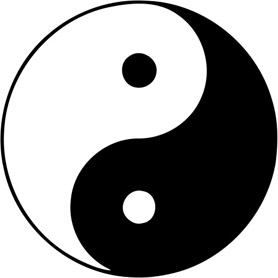
1. Taoism or Daoism is a religious or philosophical tradition of Chinese origin which emphasizes living in harmony with the Tao (“Way”).
2. The Tao is a fundamental idea in most Chinese philosophical schools.
3. In Taoism, however, it denotes the principle that is both the source, pattern and substance of everything that exists.
4. Taoism differs from Confucianism by not emphasizing rigid rituals and social.
5. Taoist ethics vary depending on the particular school, but in general tend to emphasize wu wei (effortless action), “naturalness”, simplicity, spontaneity, and the Three Treasures: “compassion”, “frugality”, and “humility”.
6. The roots of Taoism go back at least to the 4th century BCE.
7. Taoism has had a profound influence on Chinese culture in the course of the centuries.
8. Taoists (“masters of the Tao”), a title traditionally attributed only to the clergy and not to their lay followers, usually take care to note distinction between their ritual tradition and the practices of Chinese folk religion and non-Taoist vernacular ritual orders.
9. The word Taoism is used to translate different Chinese terms which refer to different aspects of the same tradition and semantic field:
“Taoist religion” (teachings of the Tao) – a family of organized religious movements sharing concepts or terminology from “Taoist philosophy”, the first of these is recognized as the Celestial Masters school.
“Taoism philosophy” (school or family of the Tao”) – the philosophical doctrines based on the texts of the I Ching, the Tao Te Ching and the Zhuangzi.
10. Traditionally, the Chinese language does not have terms defining lay people adhering to the doctrines or the practices of Taoism, who fall instead within the field of folk religion.
11. In Western sinology, Taoist, is traditionally used to translate daoshi (master of the Tao), thus strictly defining the priests of Taoism, ordained clergymen of a Taoist institution.
12. Wu-wei is the leading ethical concept in Taoism. Wei refers to any intentional or deliberated action, while wu carries the meaning of lacking or without. (i.e. action without action).
13. Naturalness describes the primordial state of all things as well as a basic character of the Tao, and is usually associated with spontaneity and creativity. To attain naturalness, one has to identify with the Tao; this involves freeing oneself from selfishness and desire, and appreciating simplicity.
14. Three Treasures or Three Jewels comprise the basic virtues of ci (translated compassion), jiam (translated moderation), and bugan wei tianxia xian (translated not daring to act as first under the heavens or humility).
15. Cosmology is cyclic; relativity, evolution and extremes meet are main characters.
16. Theology of Taoism can be defined as pantheistic, given its philosophical emphasis on the formlessness of the Tao and the primacy of the Way rather than anthropomorphic concepts of God.
17. Taoism encourages a vegetarian diet but at certain dates, food may be set out as a sacrifice to the spirits of the deceased or the gods.
18. There are four (4) components in the emergence of Taoism:
Philosophical Taoism, i.e. the Tao Te Ching and Zhuangzi
Techniques for achieving ecstasy
Practices for achieving longevity or immortality
Exorcism
19. Taoism tends to emphasize various themes such as naturalness, spontaneity, simplicity, detachment from desires, and most important of all, wu wei. However these texts cannot be equated with Taoism as a whole.
20. About 1 Billion Chinese practice some folk religion with about 200 million practicing Taoism.
21. Unlike Confucianism, Taoism favors philosophical anarchism, pluralism and laissez-faire-government.
22. Many scholars believe that Taoism arose as a countermovement against Confucianism.
23. Taoism includes some aspects of Buddhism in its practices as well as Confucianism as do each of them include Taoism in their respective practices.



Thank you for your comments. The study on Taoism was for the purpose of exposing Christian believers to the major world religions practiced by people throughout the world. It included 18 major religions as determined by the number of people practicing that religion and is not to be construed to be all inclusive of every religion being practiced. Your comments are very well taken, and the study on this site is only a part of the actual study as there were many more comments and questions asked than could be put into this posting. The study was in no way an attempt to convert anyone from one religion to another. Remember the emphasis was for Christians to learn about other religions and see the similarities and differences in other religious studies.
You teach Taoism and then throw in the Christian god??